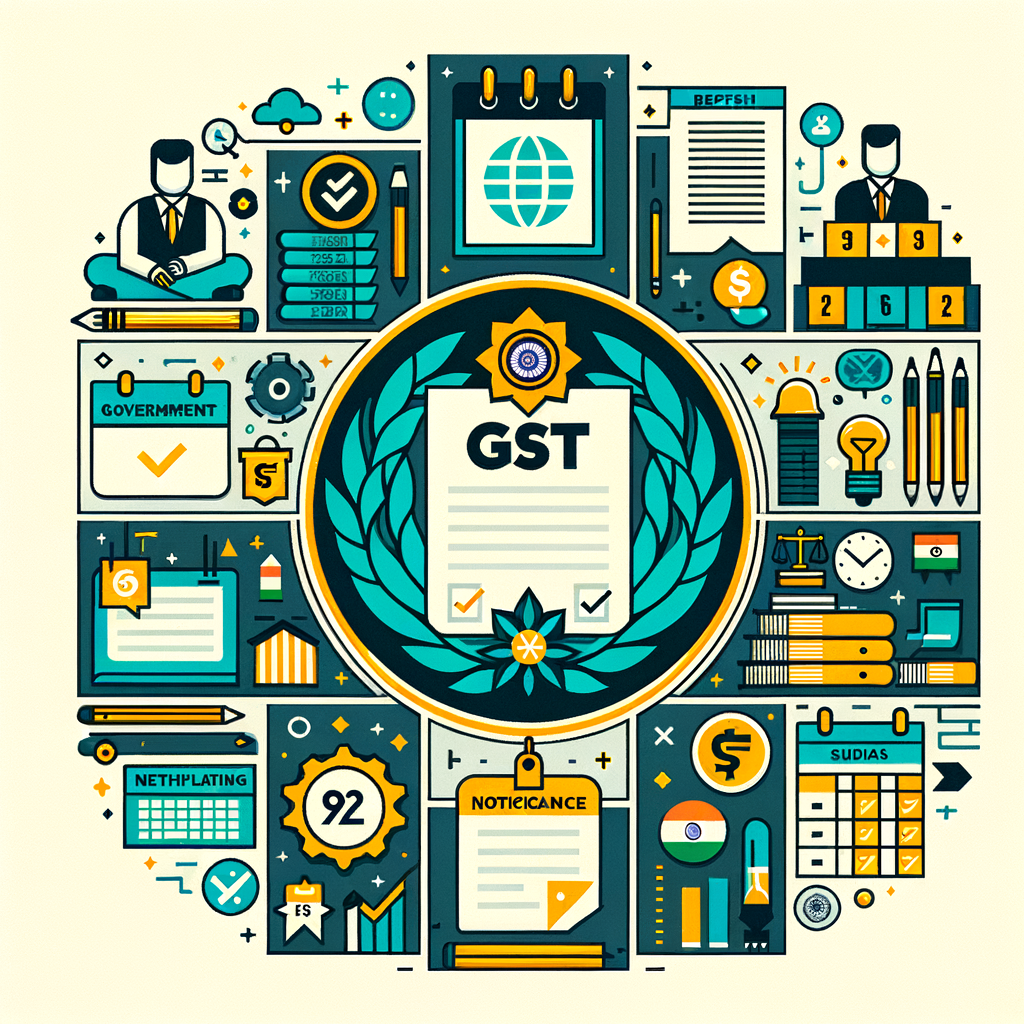GST Notifications and Circulars 2025 – Your Guide to the Latest Government Updates
The Goods and Services Tax (GST) system in India is constantly evolving. For a business owner, staying on top of these changes is not just good practice—it’s essential for survival and growth. We understand that tracking every new rule can feel like a full-time job. This guide is designed to be your go-to resource for the most important GST notifications 2025, breaking down complex legal language into simple, actionable insights. We’ll explore what these government updates 2025 news India mean for your daily operations, helping you stay compliant, avoid costly penalties, and run your business with confidence.
Why You Can’t Afford to Ignore GST Updates in 2025
Keeping up with GST amendments might seem like another task on your already long to-do list, but the benefits of staying informed are significant and directly impact your bottom line. Ignoring these updates can lead to serious complications that disrupt your business and finances. The primary reason to stay vigilant is to ensure flawless compliance and avoid penalties. The GST framework has strict rules for filing returns and paying taxes on time. Non-compliance can result in hefty late fees, interest charges on unpaid taxes, and could even trigger a detailed audit by the tax authorities. By staying informed about GST compliance updates 2025 India, you safeguard your business from unnecessary financial strain and legal trouble.
Beyond just avoiding penalties, understanding the latest GST changes is crucial for strategic business planning. For example, a change in GST rates for your raw materials or finished products directly affects your pricing strategy, profit margins, and budgeting. Similarly, alterations to the rules for claiming Input Tax Credit (ITC) can have a major impact on your working capital and cash flow. Furthermore, government updates aren’t always about new restrictions. Often, they introduce new schemes, simplified compliance procedures, or tax reliefs that can create opportunities for your business. Being among the first to know about and leverage these changes can give you a competitive edge.
Major GST Notifications 2025: What Your Business Needs to Know
This section is dedicated to the core changes introduced through various GST notifications 2025. We will break down the specifics of these announcements, explaining their practical implications for your business operations and compliance requirements.
Key Changes in GST Rates and HSN Codes
One of the most frequent updates in the GST regime involves the revision of tax rates for specific goods and services. In 2025, the GST Council may announce several such changes to rationalize the tax structure or promote certain industries. For example, a notification could alter the GST slab for electronics, textile products, or specific professional services. These GST updates 2025 for businesses require immediate action. It is critical to identify if any of your products or services are affected by these rate changes.
Actionable Tip: As soon as a rate change is announced, you must update your invoicing software, accounting systems, and product pricing lists to reflect the new GST rates. Failure to do so can lead to incorrect tax collection and payment, causing compliance issues down the line.
Here’s a hypothetical example of what a rate change notification might look like:
| HSN Code | Goods/Service Description | Old GST Rate | New GST Rate (Effective 2025) |
|---|---|---|---|
| 8471 | Laptops and Personal Computers | 18% | 12% |
| 9983 | IT Consulting Services | 18% | 18% (No Change) |
| 6204 | Readymade Garments (Value > ₹1000) | 12% | 18% |
Updates to Input Tax Credit (ITC) Rules
Input Tax Credit (ITC) Under GST 2025 – New Claim Rules is the backbone of the GST system, preventing the cascading effect of taxes. The government consistently refines the rules governing ITC to prevent tax evasion. A key update in 2025 could involve making the conditions for claiming ITC even more stringent. For instance, a new notification may require 100% matching of invoices in your GSTR-2B with the supplier’s GSTR-1 before ITC can be claimed, impacting your working capital. This means if your supplier makes a mistake or delays their filing, your ability to claim credit could be temporarily blocked, tightening your cash flow. Another potential change could be the expansion of the list of items under blocked credit (Section 17(5)), further restricting the scope of available ITC.
E-invoicing and E-Way Bill System Enhancements
The e-invoicing system is continuously being expanded to cover more businesses. A major update could be the lowering of the turnover threshold for mandatory e-invoicing. For example, the threshold might be reduced from the current ₹5 crores to ₹1 crore, bringing a large number of small and medium-sized enterprises into its ambit. Additionally, there might be system enhancements to integrate e-way bill generation more seamlessly with the e-invoicing process, reducing data entry errors and improving efficiency. It’s crucial to stay updated on these changes to ensure your invoicing process remains compliant. For the most accurate information, always refer to the official GST e-invoice portal.
Procedural Amendments in GST Return Filing
The process of filing GST returns (GSTR-1, GSTR-3B, GSTR-9) is another area prone to amendments. A significant notification might introduce new fields in GSTR-3B to provide a more detailed breakup of ITC claims or tax liabilities. There could also be changes to the due dates for filing or the introduction of new forms for specific types of taxpayers, like e-commerce operators. Understanding these procedural changes is vital for accurate and timely filing. Keeping track of the current GST notifications India 2025 will ensure you don’t miss any critical deadlines or new reporting requirements, thus maintaining a high GST compliance rating.
Decoding the Latest Government Circulars 2025 India
While notifications introduce or amend laws, circulars play an equally important role. It’s essential to understand the difference and pay close attention to the latest government circulars 2025 India to ensure you are interpreting the law correctly.
What is a GST Circular?
A GST circular is an official communication issued by the Central Board of Indirect Taxes and Customs (CBIC). Unlike a notification, which has the force of law, a circular is issued to clarify ambiguities in the existing GST law. Its purpose is to ensure that tax officials and taxpayers across the country have a uniform and consistent understanding of a particular provision. This helps prevent disputes and ensures fair application of the law.
Key Clarifications Issued in 2025
Throughout 2025, the CBIC will likely issue several circulars to address common points of confusion among businesses. For example:
- A circular might be issued to clarify the GST applicability on corporate guarantees provided by a holding company to its subsidiary, a topic that has been subject to much debate.
- Another circular could provide a detailed explanation of the tax treatment for employee reimbursements or the valuation of perks provided to employees.
- There could be clarifications on the place of supply rules for new-age digital services, helping freelancers and tech companies determine the correct tax to charge.
How to Access Official Government Circulars
To ensure you are relying on accurate information, it is always best to access these documents from the source. You can find all official notifications and the latest government circulars 2025 India directly on the CBIC website. Regularly checking this portal is a good habit for any business owner.
Actionable Checklist for GST Compliance Updates 2025 India
Adapting to new GST rules requires a systematic approach. Here is a simple checklist to help your business manage these changes effectively.
Review and Update Your Accounting Software
Check with your accounting software provider (like Tally, Zoho Books, or QuickBooks) to ensure their platform has been updated to incorporate the new GST rates, return formats, and ITC rules. A compliant software automates much of the process and reduces the risk of manual errors.
Train Your Finance and Accounting Team
Your team is your first line of defense in ensuring compliance. Organize a training session to educate them on the GST changes 2025 what to know. Ensure they understand the practical impact of these updates on day-to-day tasks like invoice creation, ITC reconciliation, and return filing.
Re-evaluate Your Pricing and Vendor Contracts
If there are any changes in GST rates for your goods or services, you must review and adjust your pricing accordingly. It’s also a good time to review your contracts with vendors. Ensure your vendors are GST-compliant, as their timely filing of returns directly impacts your ability to claim ITC.
Consult a Tax Professional
Navigating these changes can be complex. The rules are nuanced, and a misinterpretation can lead to significant issues. The experts at TaxRobo can provide personalized guidance to ensure your business remains 100% compliant with all GST notifications 2025.
Conclusion
Staying updated with the latest GST notifications 2025 is not optional; it’s a fundamental requirement for running a successful business in India. Proactive compliance is the best strategy to avoid penalties, optimize your tax planning, and maintain smooth operations. By understanding the key changes in rates, ITC rules, e-invoicing, and filing procedures, you can effectively manage your tax obligations. Remember, every update presents both a challenge and an opportunity.
Don’t let the current GST notifications India 2025 disrupt your business. Whether you need help with GST filing, understanding new rules, or annual compliance, TaxRobo is here to help. Contact us today for a consultation!
Frequently Asked Questions (FAQs) about GST Notifications 2025
FAQ 1: Where can I find the official government documents for these GST updates?
Answer: You can find all official notifications and circulars on the CBIC (Central Board of Indirect Taxes and Customs) website at www.cbic.gov.in and the official GST portal at www.gst.gov.in. These are the most reliable sources for authentic information.
FAQ 2: I am a small business owner below the GST registration threshold. Do these changes affect me?
Answer: While you may not need to file returns, these changes can affect you indirectly. For example, if the GST rate on goods you purchase from registered suppliers changes, it will impact your procurement cost. If you plan to register for GST in the future, it’s crucial to be aware of the latest rules to ensure a smooth transition.
FAQ 3: What are the common penalties for not following the latest GST compliance updates 2025 India?
Answer: Penalties can range from late filing fees (₹50/day for GSTR-3B and ₹200/day for GSTR-1, subject to a maximum cap) and interest on unpaid tax (typically 18% per annum) to more severe actions for significant non-compliance, such as cancellation of GST registration or audits.
FAQ 4: How do these GST changes affect freelancers?
Answer: If a freelancer’s aggregate turnover exceeds the threshold limit (₹20 lakhs for services in most states), they must register for GST and comply with all rules, including these new updates. Updates related to GST rates on services, place of supply rules, and procedural changes in return filing are particularly relevant for freelancers.



